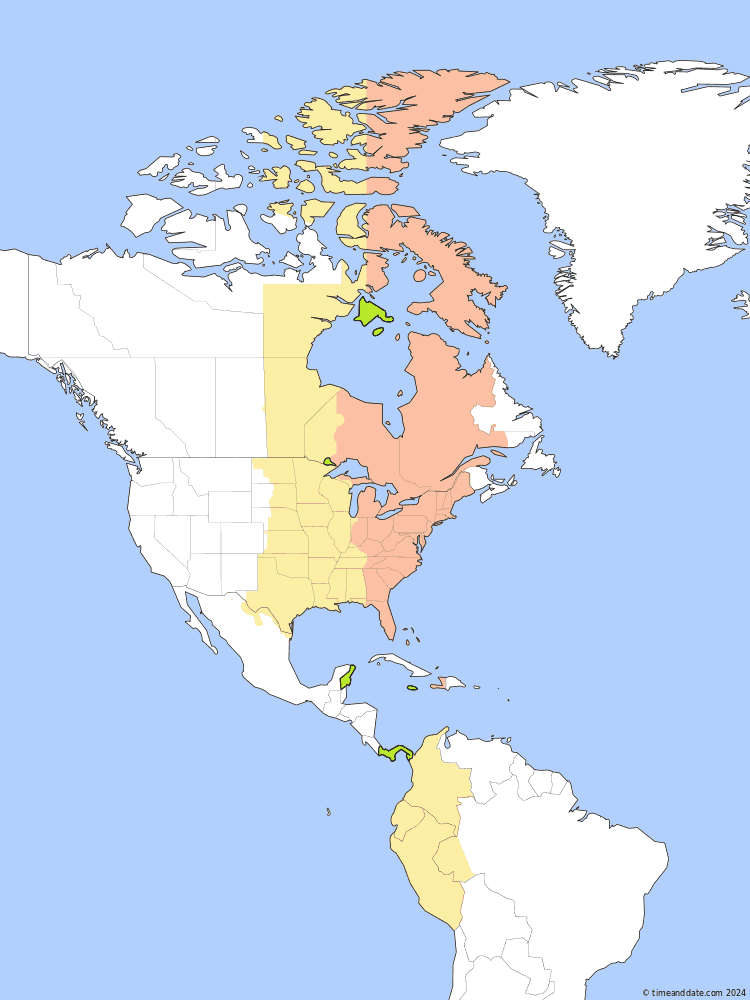Also known as: Eastern Time (ET) and Eastern Daylight Time (EDT)
Caution: This is NOT the current local time in most locations in that time zone
North America, Caribbean: Only some locations are currently on EST because most places in this time zone are currently on summer time / daylight saving time and are observing EDT.

Observes EST part of the year.
Areas with same time currently (UTC -5).
Observes EST – Eastern Standard Time part of the year, but not currently.
Currently has same time zone offset as EST (UTC -5) but different time zone name.
Eastern Standard Time (EST) is 5 hours behind Coordinated Universal Time (UTC). This time zone is in use during standard time in: North America, Caribbean, Central America.
What Is Eastern Standard Time?
Eastern Standard Time (EST) is the easternmost time zone in the United States. It is also used in Canada.
It covers all or parts of 23 states in the US and three provinces or territories in Canada. It is also used in Mexico, the Caribbean, and Central America.
Almost half of the population in the USA live in the EST time zone. It spans from northern Canada and south to Panama near the equator.
In North America, Eastern Standard Time shares a border with Atlantic Standard Time (AST) in the east and with Central Standard Time (CST) in the west.
Eastern Standard Time Zone
Eastern Standard Time (EST) is a standard time zone in use from the first Sunday in November to the second Sunday in March—when Daylight Saving Time (DST) is not in effect. Eastern Daylight Time (EDT) is used during the remainder of the year.
EST Is the Eastern Time Zone
In everyday usage, EST is often referred to as Eastern Time (ET) or the Eastern Time Zone. This can add a bit of confusion as the term Eastern Time does not differentiate between standard time and Daylight Saving Time, so Eastern Time switches between EST and EDT in areas that use DST during part of the year.
Most North American time zones also have generic terms, including Pacific Time (PT), Mountain Time (MT), Central Time (CT), and Atlantic Time (AT).
Converting Eastern Time to Other US Time Zones
- Eastern Standard Time (EST) is 1 hour ahead of Central Standard Time (CST).
To convert EST to CST, you have to subtract one hour. - Eastern Standard Time (EST) is 2 hours ahead of Mountain Standard Time (MST).
To convert EST to MST, you have to subtract two hours. - Eastern Standard Time (EST) is 3 hours ahead of Pacific Standard Time (PST).
To convert EST to PST, you have to subtract three hours.
Time Zone Converter: UTC to EST
Where and When is EST Observed?
North America
US states using EST in the winter and EDT in the summer:
- Connecticut
- Delaware
- District of Columbia
- Florida - Southern/Eastern parts
- Georgia
- Indiana - all except for these north-western counties near Chicago (Lake, Porter, La Porte, Newton, Jasper, Starke) and these south-western counties in Indiana near Evansville
- Kentucky - eastern parts
- Maine
- Maryland
- Massachusetts
- Michigan - most except these western counties
- New Hampshire
- New Jersey
- New York
- North Carolina
- Ohio
- Pennsylvania
- Rhode Island
- South Carolina
- Tennessee - eastern counties
- Vermont
- Virginia
- West Virginia
Canadian provinces/territories using EST in the winter and EDT in the summer:
- Nunavut - most of it
- Ontario - most parts east of 90 West and two communities west of 90 West
- Quebec - most of it
Canadian provinces/territories using EST all year:
Mexican states using EST all year:
Caribbean
Caribbean countries using EST in the winter and EDT in the summer:
Caribbean countries using EST all year:
Central America
Central American countries using EST all year:
Other Eastern Standard Time Zones
Time zones can have similar names and abbreviations but have a different UTC offset:
- Australian Eastern Standard Time (AEST): UTC +10
- Eastern Africa Time (EAT): UTC +3
- Eastern European Time (EET): UTC +2
- East Greenland Time (EGT): UTC -1
Other Time Zones in UTC -5
Some time zones exist that have the same offset as EST, but can be found under a different name: